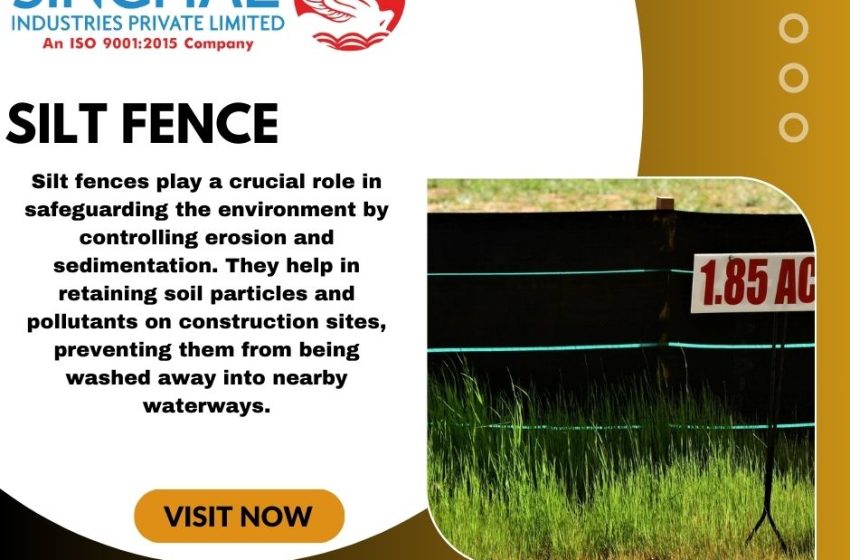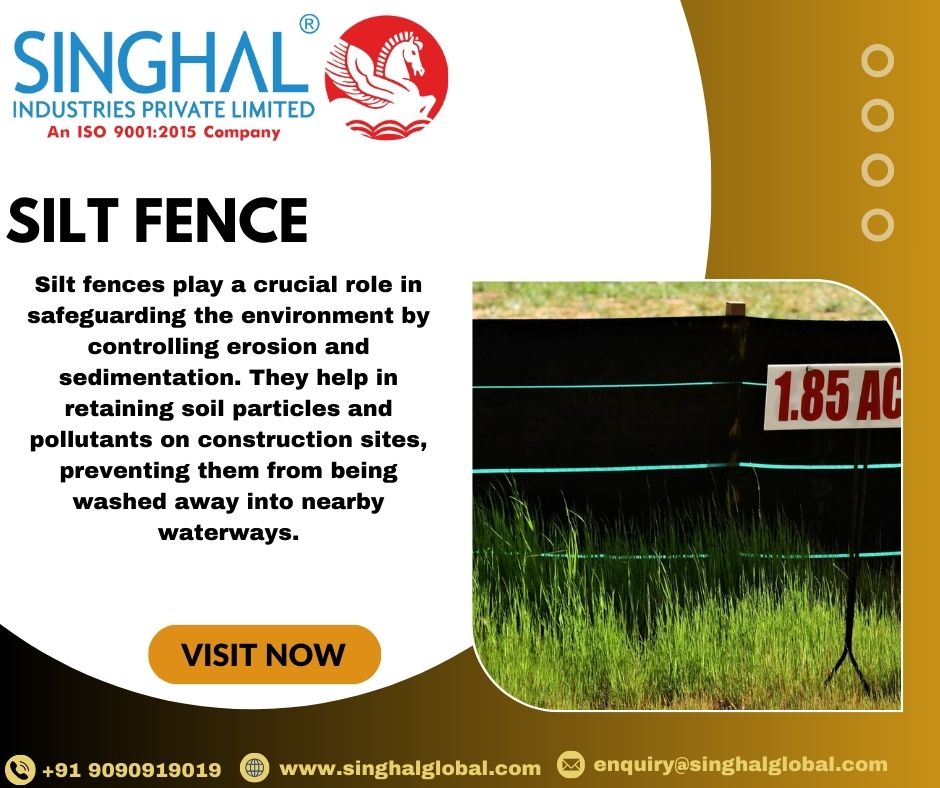Keeping Soil in Place: The Importance and Benefits of Silt Fences

Soil erosion is a significant environmental concern, particularly in construction and agricultural activities. It not only affects land productivity but also poses a threat to water quality and aquatic ecosystems. To combat this issue, various erosion control measures are employed, among which silt fences play a crucial role.
Introduction to Silt Fences
Definition and Purpose
Silt fences are sediment control devices designed to prevent soil erosion and sediment runoff from construction sites and other areas of soil disturbance. They act as barriers, intercepting sediment-laden water and allowing sediment to settle while retaining water.
Importance in Soil Erosion Control
In addition to preserving soil integrity, silt fences help maintain water quality by reducing sedimentation in nearby water bodies. This is vital for protecting aquatic habitats and complying with environmental regulations.
Understanding Soil Erosion
Soil erosion occurs when the top layer of soil is displaced by natural forces such as wind, water, or human activities like construction and farming. This process can lead to land degradation, loss of fertile soil, and increased sedimentation in waterways.
Causes and Effects
Factors contributing to soil erosion include rainfall intensity, slope steepness, vegetation removal, and soil composition. The effects of soil erosion extend beyond land degradation to include sediment pollution, reduced water quality, and habitat destruction.
Environmental Impact
Uncontrolled soil erosion not only affects agricultural productivity but also has detrimental effects on ecosystems. Sediment runoff can smother aquatic habitats, degrade water quality, and disrupt aquatic life cycles, leading to long-term environmental damage.
What are Silt Fences?
Composition and Structure
Silt fences typically consist of a geotextile fabric stretched between wooden or metal stakes driven into the ground. The fabric allows water to pass through while trapping sediment particles, preventing them from reaching sensitive areas.
Functionality and Installation Process
During installation, silt fences are strategically placed downslope from disturbed areas, such as construction sites or farmland. They are anchored securely to the ground and inspected regularly to ensure effectiveness.
Benefits of Using Silt Fences
Preventing Sediment Runoff
By intercepting sediment-laden water, silt fences help prevent soil erosion and reduce the transport of sediment to nearby water bodies.
Protecting Water Quality
By minimizing sedimentation, silt fences contribute to improved water quality, benefiting aquatic ecosystems and human health.
Compliance with Regulations
Many environmental agencies require the implementation of erosion control measures like silt fences to mitigate the impact of land-disturbing activities and ensure regulatory compliance.
Factors to Consider When Choosing Silt Fences
Site Conditions
Factors such as soil type, slope gradient, and rainfall patterns influence the selection and installation of silt fences.
Durability and Longevity
Quality construction and proper maintenance are essential for ensuring the longevity and effectiveness of silt fences.
Cost-effectiveness
While silt fences offer significant benefits in erosion control, their cost-effectiveness depends on factors such as installation expenses and maintenance requirements.
Silt Fence Rolls: A Convenient Solution
Overview of Silt Fence Rolls
Silt Fence Rolls provide a convenient and cost-effective solution for sediment control. They come in various sizes and configurations to suit different project requirements.
Advantages and Applications
Silt fence rolls are easy to transport, install, and maintain, making them suitable for a wide range of applications, from small-scale landscaping projects to large construction sites.
Silt Barrier Fence: How It Works
Mechanism of Silt Barrier Fence
Similar to traditional silt fences, Silt Barrier Fences are designed to intercept sediment-laden water. However, they offer enhanced filtration capabilities and are often used in areas with high sediment loads.
Efficiency in Erosion Control
Silt barrier fences are highly efficient in controlling sediment runoff, making them ideal for protecting sensitive environments and water bodies.
Singhal Industries: Leading Silt Fence Manufacturer
Company Profile
Singhal Industries is a reputable Silt Fence Manufacturer erosion control products, including silt fences, silt barrier fences, and geotextile fabrics.
Product Range and Quality Assurance
Singhal Industries offers a comprehensive range of silt fence products designed to meet the highest standards of quality and performance. Their products undergo rigorous testing to ensure durability and effectiveness.
Case Studies: Successful Implementation of Silt Fences
Real-world Examples
Numerous case studies demonstrate the effectiveness of silt fences in controlling erosion and preserving soil and water quality.
Positive Impacts and Results
From construction sites to agricultural fields, silt fences have been instrumental in mitigating the environmental impact of soil erosion and sediment runoff.
Tips for Proper Maintenance of Silt Fences
Regular Inspections
Inspect silt fences regularly for signs of damage or wear, and repair or replace them as needed to maintain effectiveness.
Repair and Replacement
Promptly address any damage to silt fences to prevent sediment leakage and ensure continued erosion control.
Best Practices
Follow recommended guidelines for silt fence installation and maintenance to optimize performance and longevity.
Environmental Benefits of Silt Fences
Habitat Preservation
By reducing sedimentation in water bodies, silt fences help preserve aquatic habitats and biodiversity.
Soil Conservation
Silt fences play a vital role in conserving soil resources and preventing soil degradation, thus supporting sustainable land use practices.
Contribution to Sustainable Land Use
Through effective erosion control, silt fences contribute to the sustainable management of natural resources and ecosystems.
Conclusion
Silt fences are essential tools for preventing soil erosion, protecting water quality, and preserving environmental integrity. By implementing silt fences and adhering to best practices in erosion control, we can mitigate the adverse effects of soil erosion and promote sustainable land use.
FAQs
-
Are silt fences suitable for all soil types? Silt fences are effective in most soil types but may require modifications for highly erosive soils.
-
How long do silt fences last? The lifespan of silt fences depends on various factors, including site conditions and maintenance practices, but they typically last for several months to a few years.
-
Can silt fences be recycled? Yes, many silt fence materials are recyclable, contributing to environmental sustainability.
-
Are silt fences environmentally friendly? Silt fences are environmentally friendly as they help prevent soil erosion and protect water quality, benefiting ecosystems and aquatic habitats.
-
What are the regulations regarding silt fence installation? Regulations vary by region, but most environmental agencies require the use of erosion control measures like silt fences in land-disturbing activities to minimize environmental impact.


